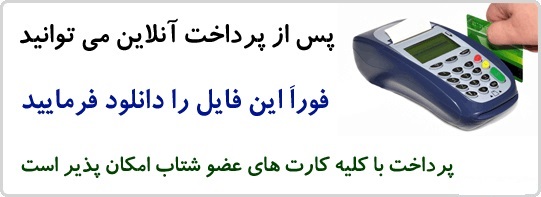لینک دانلود و خرید پایین توضیحات
فرمت فایل word و قابل ویرایش و پرینت
تعداد صفحات: 10
Layer soil
What is Soil? Soil is made up of several layers—we call the set of layers the “soil profile.” The major layers of the soil profile are (from top to bottom):
·Organic Layer: The top layer of soil is called the “Organic layer” or “topsoil.” This rich, dark layer has many nutrients to support plant growth.
·Subsoil: The next soil layer down from the topsoil is the subsoil. This layer of soil has a high mineral content, which comes from weathering of the bedrock underneath. The subsoil has some organic content, but doesn’t support plant growth very well because it lacks nitrogen and phosphorus nutrients.
·Mineral layer: The lowest level of the soil has almost no organic material in it, and is almost all mineral material. The mineral layer doesn’t support plant growth. It is derived from weathering of the underlying bedrock layer, and is mostly sand and rock.
·Bedrock: Deep down, under the soil layers is the bedrock. This rock is the “parent material” for the mineral part of soil—that means that all of the mineral components of soil come from the bedrock. As the bedrock layer gets weathered (broken down), the minerals move into the upper layers of the soil.
What is a Soil Component?
► Soil has many “Components.” By “components” we mean the different types of materials that make up the soil. Each soil layer can have some or all of the different types of soil components—which soil components are most abundant in a particular layer determines the characteristics of that soil layer. If we want to understand the science of soil, we need to understand how the different soil components make the soil behave the way it does. There are many millions of different materials that make up soil, but they can all be grouped into two large categories: Organic material and Mineral material.
·Organic Material: Any material (molecules) in soil that comes from the break down of plant or animal material is called “organic.” Some parts of plants and animals break down very quickly, and some break down more slowly. Think about a squashed tomato. The inside of the tomato is very soft and watery—this part would break down very quickly in the environment. The outside of the tomato—the tomato skin—is much tougher, and would break down very slowly. The parts of plants and animals that break down very slowly—like tomato skins, or wood, or the skin of cactus leaves—are more important in soil, because they stick around longer.
·Mineral Material: The part of the soil that comes from the weathering of bedrock is called the “mineral material” of soil. This component of soil includes large particles—like sand and gravel—and very tiny particles—like silt and clay. Mineral material in soil is very important as a source of mineral nutrients for plants (like Iron or Calcium), but doesn’t contain organic nutrients (like vitamins).
Soil Layers
Soil covers much of the land on Earth. It is made up of minerals (rock, sand, clay, silt), air, water, and organic (plant and animal) material.
Types of Soil: There are many different types of soils, and each one has unique characteristics, like color,

مقاله درباره Layer soil



